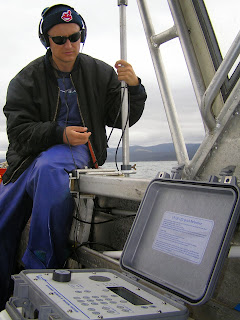In our first post in this series, we covered passive
acoustic tracking, a method of tracking marine animals. In this post, we look
at a second method using sound – active acoustic tracking.
Active Acoustic Tracking
Active tracking can be likened to follow the leader, or a game of hide and seek. It differs from
passive tracking because it relies on real-time listening and following the sound, rather than using a stationery receiver to record the information. It allows us to build a fine scale map of the animal's movements and behaviours.
Just as in passive acoustic tracking,
active acoustic tracking also requires 2 components.
- A transmitter attached to the animal, and
- A receiver, often with a hydrophone.
 |
| The transmitters (tags) come in a variety of sizes |
 |
Adam Barnett listening to the pings emitted by the transmitter placed on a sevengill shark. Note the portable receiver built into the grey case.
|
How it works
The acoustic tag is attached to the animal and transmits a signal, or ping, at
a pre-programmed rate (e.g. every second) at a set frequency. The portable
receiver has a channel set for the given frequency, and using a hydrophone to
listen for the sound, we carefully follow the tagged animal in a boat or kayak.
As the animal moves, the sound changes in volume, indicating the changes in distance and direction of the animal. The researcher constantly swivels the hydrophone to find the strongest signal and continues to follow in that direction.
As the animal moves, the sound changes in volume, indicating the changes in distance and direction of the animal. The researcher constantly swivels the hydrophone to find the strongest signal and continues to follow in that direction.
As we track the sound, the portable
receiver automatically records the position of our boat/kayak. This becomes the
reflection of the animal’s track. The closer we can stick to the animal
without influencing its movement, the more accurate our data is.
This work is, in all honesty, exhausting, and after the first hour or so extremely boring. Animals can normally only be tracked for short periods of time in comparison to passive tracking, but very fine-scale movement data can be collected, and the detailed results can be quite exciting.
This work is, in all honesty, exhausting, and after the first hour or so extremely boring. Animals can normally only be tracked for short periods of time in comparison to passive tracking, but very fine-scale movement data can be collected, and the detailed results can be quite exciting.
Active acoustic tracking in use
We use active acoustic tracking on a number of types of animals. Associate Professor Jamie Seymour has successfully used active acoustic tracking on the fragile but deadly box jellyfish. Jamie used small transmitters carefully glued to the bell.
 |
| The transmitter is attached to the jellyfish bell using surgical glue |
 |
| The jellyfish is then released into the water... |
 |
| ...and the researchers (Jamie Seymour shown here) listen and follow the pings continually to map the jellyfish's movements over the coming hours. |
When do we use active acoustic tracking?
Active acoustic tracking is great for
determining how an animal uses their habitat or learning about foraging behaviour. It can also give us a good idea of the use of space if
we have no previous idea of where these animals get to. Actively tracking a few
individuals from a species first can also help in deciding the best acoustic
array design for long term monitoring with passive acoustic systems.
Below is an example of the tracks from 2
sevengill sharks in coastal areas of Tasmania. For this study, we attached the transmitters to the shark just behind the dorsal fin. The bold black lines are the
tracks. While the shark in Norfolk Bay (far right) stayed in relatively the same area, the shark in the Derwent Estuary (left) travelled more than 37 km in 22 hours.
Tags can also be programmed to send the depth the animal is at. These are pressure tags. The 2nd graph below shows the depth the shark used
at different times during the track in the Derwent Estuary, note that during the day the sharks is
close to the bottom, but at night it displays a yo-yo behaviour that could be associated
with foraging.
Above: Data illustrates the depth
profile over representative 1 h periods during the day (16:00–17:00 h), dusk
(20:00–21:00 h), night (01:00–02:00 h) and dawn (05:00–06:00 h) periods for the
sevengill shark individual tracked in the Derwent Estuary
Click here to see the published paper, or visit our sevengill project page at the OceansIQ website for more information about this project.
There is also other types of acoustic tags that record
depth (as in the graph above), temperature and activity – but that's probably enough hide and seek for now. Stay tuned for our next post in this series - satellite transmitters.
UPDATE:
For more information on tracking and tagging marine animals, check out our other posts:
UPDATE:
For more information on tracking and tagging marine animals, check out our other posts:



No comments:
Post a Comment